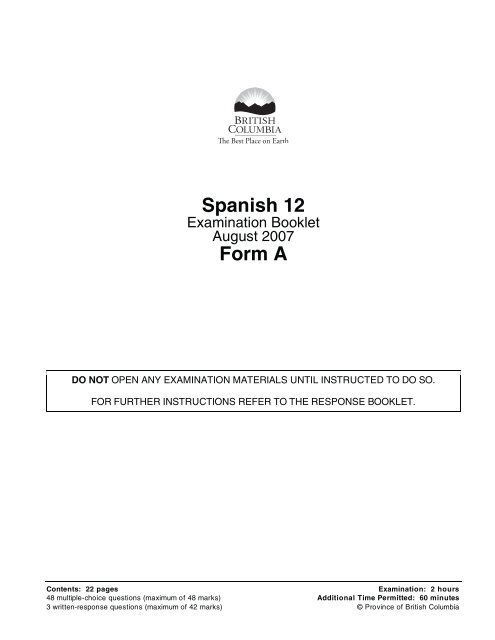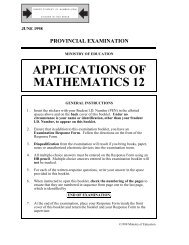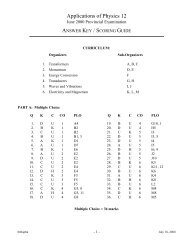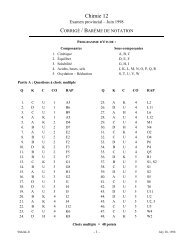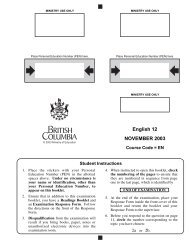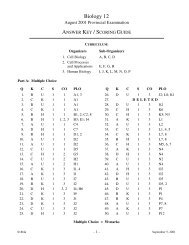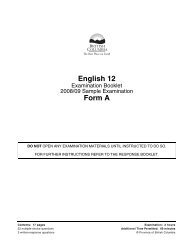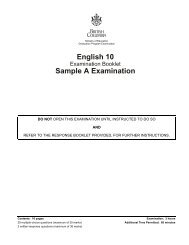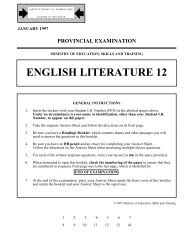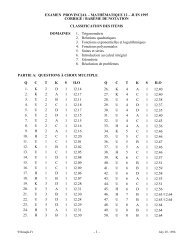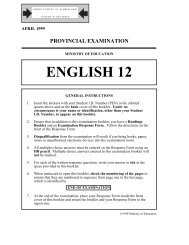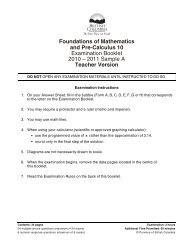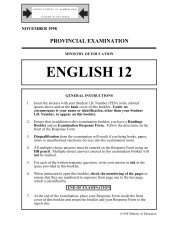Spanish 12 Form A - QuestionBank.CA
Spanish 12 Form A - QuestionBank.CA
Spanish 12 Form A - QuestionBank.CA
Create successful ePaper yourself
Turn your PDF publications into a flip-book with our unique Google optimized e-Paper software.
<strong>Spanish</strong> <strong>12</strong><br />
Examination Booklet<br />
August 2007<br />
<strong>Form</strong> A<br />
DO NOT OPEN ANY EXAMINATION MATERIALS UNTIL INSTRUCTED TO DO SO.<br />
FOR FURTHER INSTRUCTIONS REFER TO THE RESPONSE BOOKLET.<br />
Contents: 22 pages<br />
Examination: 2 hours<br />
48 multiple-choice questions (maximum of 48 marks) Additional Time Permitted: 60 minutes<br />
3 written-response questions (maximum of 42 marks) © Province of British Columbia
You have Examination Booklet <strong>Form</strong> A. In the box above #1 on your Answer Sheet, fill in<br />
the bubble as follows.<br />
Exam Booklet <strong>Form</strong>/<br />
Cahier d’examen<br />
A B C D E F G H<br />
<strong>Spanish</strong> <strong>12</strong> – 0708 <strong>Form</strong> A Page 1
Value: 10 marks<br />
PART A: LINGUISTIC COMPETENCY COMPONENT<br />
SECTION 1 – CLOZE PASSAGE<br />
Suggested Time: 10 minutes<br />
INSTRUCTIONS: For questions 1 to 10, select the answer which best completes the sentence and record<br />
your choice on the Answer Sheet provided. Using an HB pencil, completely fill in<br />
the bubble that has the letter corresponding to your answer.<br />
Receta para La Fiesta Perfecta<br />
Ponle sentimiento a tu fiesta. La ranchera es un estilo de música popular mexicana. Está íntimamente<br />
asociada con los grupos de mariachis 1 se desarrollaron en Jalisco a comienzos 2 siglo XX.<br />
El 3 deriva de la palabra RANCHO, que es una hacienda 4<br />
ya que ése fue precisamente su origen.<br />
a la explotación agrícola y ganadera,<br />
Los mariachis 5 a popularizar la ranchera en las fiestas de casamiento en los ranchos, pero poco a poco<br />
se fue convirtiendo en un símbolo de una 6 conciencia nacional en oposición a los gustos aristocráticos<br />
7 época.<br />
A lo largo del camino, la ranchera 8 inspiración en el espíritu de las danzas folklóricas mexicanas, de<br />
fuerte carácter festivo. Antes y hoy, su característica al cantarla es el mantenimiento prolongado de la nota<br />
del final de cada frase en un tono agudo 1 que completa la estrofa. Por eso, 9 mejores intérpretes son los<br />
mariachis, conjuntos instrumentales de tres a doce integrantes que<br />
alternan 10 instrumentos de cuerda y metales como la<br />
trompeta y el clarinete. Por eso, si quieres ponerle<br />
sentimiento a tu fiesta, que toquen y bailen ranchera.<br />
1 agudo: high-pitched<br />
Adapted from a Kraft Foods advertisement. ComidaKraft.com<br />
Page 2<br />
<strong>Spanish</strong> <strong>12</strong> – 0708 <strong>Form</strong> A
1. A. que<br />
B. cual<br />
C. quien<br />
D. cuanto<br />
6. A. nieve<br />
B. nueva<br />
C. nuevo<br />
D. nueve<br />
2. A. de<br />
B. en<br />
C. del<br />
D. de la<br />
7. A. de<br />
B. del<br />
C. de la<br />
D. de lo<br />
3. A. nombre<br />
B. número<br />
C. nominado<br />
D. nominación<br />
8. A. encontró<br />
B. encontrar<br />
C. encontrará<br />
D. encontrando<br />
4. A. dedicar<br />
B. dedicada<br />
C. dedicado<br />
D. dedicación<br />
9. A. su<br />
B. sus<br />
C. suyo<br />
D. suya<br />
5. A. comenzó<br />
B. comenzar<br />
C. comenzarán<br />
D. comenzaron<br />
10. A. a<br />
B. en<br />
C. entre<br />
D. antes<br />
<strong>Spanish</strong> <strong>12</strong> – 0708 <strong>Form</strong> A Page 3
SECTION 2 – AUTHENTIC DOCUMENT A<br />
Value: 9 marks<br />
Suggested Time: 10 minutes<br />
INSTRUCTIONS: Read the following information carefully. For questions 11 to 19, select the best<br />
answer and record your choice on the Answer Sheet provided. Your answers must<br />
be based on the information provided.<br />
Andalucía<br />
Andalucía es la comunidad más extensa y meridional de España, con<br />
2<br />
87.268 km de superficie. Tiene tres grandes unidades de relieve: al norte,<br />
las montañas de la Sierra Morena; en el centro, el valle del Guadalquivir,<br />
y al sur, las montañas de las Cordilleras Béticas.<br />
Su clima general es de tipo mediterráneo. Se caracteriza por sus<br />
veranos secos y calurosos y unos inviernos de temperaturas suaves,<br />
con precipitaciones irregulares. Sin embargo, en la gran extensión de su<br />
territorio se dan regiones de climas contrastados, desde áreas de<br />
desierto a sierras con temporadas de lluvia y montañas nevadas. El<br />
rasgo más distintivo del clima andaluz es el número de horas de sol al<br />
año que disfruta en general, con más de 3.000 en el Bajo Guadalquivir,<br />
costa atlántica y litoral de Málaga, Granada y Almería.<br />
Este clima produce una atmósfera de luz que afecta<br />
el carácter de la gente. Son innumerables los<br />
testimonios literarios que confirman esto. En<br />
gran parte las cualidades que adornan al ser<br />
andaluz, la hospitalidad y el concepto de la<br />
calidad de vida, tienen mucho que ver con unos<br />
cielos purísimos y unas temperaturas agradables.<br />
La distribución de los núcleos de población superiores<br />
a los 20.000 habitantes señalan las áreas de mayor<br />
densidad demográfica a lo largo del valle del<br />
Guadalquivir y de las costas atlántica y mediterránea.<br />
Adapted from information in Andalucía—Guídas Prácticas.<br />
Turismo Andaluz S.A. Centro Internacional de Turismo de Andalucía.<br />
Page 4<br />
<strong>Spanish</strong> <strong>12</strong> – 0708 <strong>Form</strong> A
11. How can the province of Andalusia best be described<br />
A. It is the largest.<br />
B. It is the smallest.<br />
C. It is the most mountainous.<br />
D. It is the most centrally located.<br />
<strong>12</strong>. Geographically, Andalusia is made up of three different regions. Identify them.<br />
A. three distinct mountain ranges<br />
B. a river, a lake region and a coastal area<br />
C. two mountain ranges with a valley in the middle<br />
D. the high plains, a lake region and a mountain range<br />
13. Generally, the climate includes<br />
A. very long rainy periods.<br />
B. dry summers and cold winters.<br />
C. dry hot summers and warm winters.<br />
D. tropical weather with unexpected rain showers.<br />
14. There are, however, specific areas that are subject to<br />
A. desert wind storms.<br />
B. distinct climate conditions.<br />
C. almost constant precipitation.<br />
D. extreme winter weather conditions.<br />
15. According to the brochure, why is the Andalusian climate famous<br />
A. for the windy Atlantic coastline<br />
B. for the many hours of sunshine per year<br />
C. for the longest summer season in Europe<br />
D. for the long days with the most hours of daylight in Europe<br />
<strong>Spanish</strong> <strong>12</strong> – 0708 <strong>Form</strong> A Page 5
THIS PAGE INTENTIONALLY BLANK<br />
Page 6<br />
<strong>Spanish</strong> <strong>12</strong> – 0708 <strong>Form</strong> A
16. According to the article, what has been influenced by the Andalusian climate<br />
A. the people<br />
B. the air quality<br />
C. the atmosphere<br />
D. the arts in Spain<br />
17. How does the author describe the residents of Andalusia<br />
A. They resist change.<br />
B. They love the outdoors.<br />
C. They are friendly and appreciate life.<br />
D. They are educated and enjoy reading.<br />
18. Which communities are indicated on the map<br />
A. those with 20 000 residents or less<br />
B. those with 20 000 residents or more<br />
C. those with 20 000 foreign residents or more<br />
D. those that can accommodate up to 20 000 tourists during the summer season<br />
19. Most people live<br />
A. outside of the Guadalquivir region.<br />
B. in cities of fewer than 20 000 people.<br />
C. on the Atlantic and Mediterranean coast.<br />
D. in the Guadalquivir and the coastal regions.<br />
<strong>Spanish</strong> <strong>12</strong> – 0708 <strong>Form</strong> A Page 7
Value: 8 marks<br />
SECTION 2 – AUTHENTIC DOCUMENT B<br />
Suggested Time: 10 minutes<br />
INSTRUCTIONS: Read the following information carefully. For questions 20 to 24, select the best<br />
answer and record your choice on the Answer Sheet provided. Your answers must<br />
be based on the information provided.<br />
La cena de Navidad va a ser en tu casa<br />
Quiero cocinar.<br />
¿Cómo lo hago<br />
o<br />
Un libro dedicado a quienes quieren aprender a cocinar y no saben cómo. Aquí encontrarás una<br />
explicación de los términos más usados, el equipo básico que debe haber en la cocina, una tabla de<br />
medidas y un recetario básico para todo tipo de comidas. Encontrarás desde una sopa de fideos<br />
hasta un suflé de espinacas pasando por un pastel de chocolate. Las recetas corresponden a la<br />
época del año, para que puedas organizar tus comidas con los mejores ingredientes de la<br />
temporada. Si quieres recibir a tus familiares para Navidad, aprovecha los dos menús para festejar.<br />
Déjate llevar de la mano por la autora, quien explica paso a paso las recetas. Buena suerte, y<br />
recuerda leer la receta con calma antes de empezar a cocinar.<br />
Quiero cocinar. ¿Cómo lo hago<br />
Laura B. de Caraza Campos, Editorial Planeta, de venta en Gandhi (gandhi.com.mx), costo $93.<br />
Time Out México DF. December 2004.<br />
Page 8<br />
<strong>Spanish</strong> <strong>12</strong> – 0708 <strong>Form</strong> A
20. Who would be most interested in the book reviewed in this article<br />
A. someone who does not know how to cook<br />
B. someone who wants to prepare simple, inexpensive meals<br />
C. someone who would like to learn traditional Mexican cooking<br />
D. someone who wants to prepare sophisticated and elegant meals<br />
21. What information cannot be found in this book<br />
A. a recipe organizer<br />
B. the use of seasonal ingredients<br />
C. basic recipes for all types of meals<br />
D. an explanation of common cooking terms<br />
22. What special feature(s) does the book contain<br />
A. a family restaurant guide<br />
B. day-to-day meal planning<br />
C. an editorial comment by the author<br />
D. recipes organized around the seasons<br />
23. What special meals are offered in the book<br />
A. New Year’s dinner<br />
B. a birthday party menu<br />
C. two menus for Christmas dinner<br />
D. one New Year’s dinner and one Christmas dinner<br />
24. What should you do before attempting a recipe from this book<br />
A. Wash your hands.<br />
B. Prepare the ingredients.<br />
C. Read through the recipe.<br />
D. Assemble the necessary equipment.<br />
<strong>Spanish</strong> <strong>12</strong> – 0708 <strong>Form</strong> A Page 9
Value: 4 marks<br />
SECTION 2 – AUTHENTIC DOCUMENT C<br />
Suggested Time: 8 minutes<br />
INSTRUCTIONS: Read the following information carefully. For questions 25 to 28, select the best<br />
answer and record your choice on the Answer Sheet provided. Your answers must<br />
be based on the information provided.<br />
TE MUERDE UNA SERPIENTE<br />
Toma horas o días para camines o te levantes a menos que sea<br />
que el veneno de la absolutamente necesario. Lo mejor es que entre<br />
mayoría de las<br />
dos te suban al coche y que traten de que tus<br />
serpientes pueda matar piernas queden extendidas y se muevan lo menos<br />
a una persona, pero con posible. Mientras te trasladan al hospital,<br />
los antídotos que hay asegúrate de que alguien llame y avise lo que te<br />
ahora, las mordidas de pasó, de esa manera al llegar al hospital ellos ya<br />
serpiente no son tan estarán preparados.<br />
graves como antes.<br />
PROTECCIÓN DE <strong>CA</strong>DA DÍA:<br />
Después de una mordida de serpiente lo primero<br />
es evitar que el veneno se expanda. Lo mejor es<br />
• Evita atravesar por llanos y pastos altos.<br />
atar 1 el area arriba la mordida fuertemente lo más • Sé precavida en las épocas del año en que<br />
rápido posible. Lo ideal sería que fuera con una las serpientes abundan.<br />
venda 2 , pero seguramente no tendrás una a la<br />
• Si encuentras una víbora mantén la calma, no<br />
mano, así que deberás improvisar con una media,<br />
te muevas o trates de lastimarla, lo mejor es<br />
un pedazo de tela o una toalla. La presión debe<br />
esperar a que se aleje y entonces deberás<br />
ser fuerte pero no que corte la circulación. No<br />
retroceder con mucha calma.<br />
trates de lavar la herida o de exprimirla. No<br />
1 atar: to tie<br />
2 venda: bandage<br />
Veintitantos. January 2005.<br />
Page 10<br />
<strong>Spanish</strong> <strong>12</strong> – 0708 <strong>Form</strong> A
25. Why are snake bites not as serious as they used to be<br />
A. Most poisonous snakes are now extinct.<br />
B. There are much better remedies available.<br />
C. Most snake bites take several days to be fatal.<br />
D. Snake poisons are less venomous than before.<br />
26. If you are bitten by a snake, what is the most important first step<br />
A. Try to extract the poison.<br />
B. Wash around the wound carefully.<br />
C. Wrap a cloth tightly above the wound.<br />
D. Stay calm and cover yourself with a blanket.<br />
27. When being transported to the hospital after a bite, you should<br />
A. sit still with your legs straight out.<br />
B. sit between two other passengers if possible.<br />
C. sit up straight and move your legs if necessary.<br />
D. sit still but massage the wound for good circulation.<br />
28. What should you do if you encounter a snake<br />
A. Stay calm and do not move.<br />
B. Try to frighten the snake away.<br />
C. Move away calmly and slowly.<br />
D. Move away quickly to avoid injury.<br />
<strong>Spanish</strong> <strong>12</strong> – 0708 <strong>Form</strong> A Page 11
SECTION 3 – JOURNALISTIC PROSE<br />
Value: 8 marks<br />
Suggested Time: <strong>12</strong> minutes<br />
INSTRUCTIONS: Read the following article carefully. For questions 29 to 36, select the best answer<br />
and record your choice on the Answer Sheet provided. Your answers must be based<br />
on the article.<br />
Churros…¡por fin en Vancouver!<br />
La novedad del verano vancouverita 2005<br />
Cuando Tito y Beatriz Ohep se propusieron<br />
establecer un negocio propio para sacar mejor<br />
partido a sus capacidades tanto de trabajo como<br />
empresariales, tal vez no sospechaban que<br />
darían un golpe certero en el corazón de los<br />
latinoamericanos que viven en Vancouver.<br />
Tras largos meses de investigación y luego de<br />
desarrollar un detallado ‘business plan’ estos<br />
jóvenes emprendedores<br />
lanzaron en junio pasado<br />
“Churrolicious”, una tienda que<br />
vende churros en variadas<br />
formas y al más puro estilo<br />
tradicional. Esta delicia cuando<br />
se acompaña de un espeso<br />
chocolate caliente despierta<br />
inmediatamente los recuerdos<br />
del pasado. Nos lleva al lugar<br />
que ocupa en nuestra memoria<br />
emotiva la sensación crujiente<br />
pero delicada de esta masa que nos acarició<br />
tiempo atrás en nuestras tierras originarias.<br />
Esta tradición adquirida de los españoles cuando<br />
se establecieron en tierras americanas se<br />
expandió rápidamente por todo el continente y se<br />
transformó en un alimento común a todas las<br />
naciones latinoamericanas. Cada cultura le fue<br />
agregando sus propias peculiaridades y es muy<br />
natural que hoy conozcamos no sólo el churro<br />
tradicional, sino una amplia gama de variedades:<br />
churro con canela, churro con azúcar, churro<br />
relleno con dulce de leche o fresa o chocolate o<br />
bañados en chocolate o leche condensada, en fin,<br />
un sinnúmero de variantes para el mismo<br />
producto. Lo que está claro es que todos los<br />
conocemos. Y la participación de Churrolicious<br />
en el Latin Summer Festival del domingo pasado<br />
fue tan sólo una comprobación de la popularidad<br />
de los churros dentro de la<br />
comunidad residente. La fila<br />
para comprarlos era extensa<br />
y pudimos constatar que<br />
durante todo el día se<br />
mantuvo igual, grandes y<br />
chicos, uno tras otros<br />
desfilaban por el stand de<br />
Churrolicious para adquirir<br />
tan preciado manjar. Un<br />
éxito total.<br />
“Churrolicious” está ubicado<br />
en el 3143 de W. Broadway en Vancouver. Allí se<br />
preparan en el momento todas las variantes de<br />
churros que mencionábamos y se pueden<br />
acompañar del exquisito chocolate caliente a la<br />
española o café, también, en una amplia variedad<br />
de tamaños y mezclas. La particularidad, sin<br />
embargo, es que el grano de café que se utiliza<br />
es 100% orgánico y responde a los parámetros<br />
del “fair trade” o “trato justo” en todos los<br />
aspectos de producción, procesamiento y<br />
distribución del café.<br />
Page <strong>12</strong><br />
<strong>Spanish</strong> <strong>12</strong> – 0708 <strong>Form</strong> A
El lugar está muy bien decorado, y los tonos de<br />
su espacio son cálidos, alegres y acogedores.<br />
Se respira limpieza y pulcritud en la preparación<br />
de los churros y en las mesas del local. Una<br />
mención especial se merecen la dedicación y<br />
esmero con que los dueños de Churrolicious y el<br />
personal que allí labora atienden al público. Si el<br />
producto nos recuerda nuestras tierras, Tito,<br />
Beatriz y su equipo logran hacernos sentir en<br />
casa.<br />
Qué bueno que estén aquí y esperamos que la<br />
fiebre de los churros invada también a la cultura<br />
local y veamos surgir por todas partes de la<br />
ciudad nuevas tiendas de Churrolicious.<br />
Milenio. August 23, 2005.<br />
29. When Tito and Beatriz Ohep decided to start their own business,<br />
A. they expected to enjoy work as if it were a game.<br />
B. they wanted to apply their business skills and their energy.<br />
C. they decided to locate their store in the heart of Vancouver.<br />
D. they knew they were going to make a hit with Latin Americans in Vancouver.<br />
30. Which statement about Tito and Beatriz is true<br />
A. They started developing their idea last June. After many months, they opened their store.<br />
B. They worked for a long time researching their possibilities. Last June, they opened<br />
their store.<br />
C. They worked for many months researching their idea. Last June, they finished their<br />
business plan.<br />
D. They had to work at their research jobs for many long months. Finally, they had enough money<br />
to open their store.<br />
31. Which way of eating churros awakens memories of the past<br />
A. eating them while drinking hot chocolate<br />
B. eating them coated in chocolate and sugar<br />
C. eating them with the traditional ingredients<br />
D. eating them while drinking a particular type of coffee<br />
<strong>Spanish</strong> <strong>12</strong> – 0708 <strong>Form</strong> A Page 13
THIS PAGE INTENTIONALLY BLANK<br />
Page 14<br />
<strong>Spanish</strong> <strong>12</strong> – 0708 <strong>Form</strong> A
32. Where did the “churros” tradition originate<br />
A. The Spaniards introduced it, and it spread throughout the continent.<br />
B. The Spaniards acquired the tradition when they settled in the Americas.<br />
C. The Spaniards brought it and imposed it as part of the basic diet in Latin America.<br />
D. The Spaniards discovered it in Latin America and spread it throughout the continent.<br />
33. At the Latin Summer Festival, Churrolicious<br />
A. had free samples for the residents.<br />
B. had such a success that it sold out.<br />
C. had a long line-up throughout the day.<br />
D. had different sizes of churros for young and old.<br />
34. The coffee served at Churrolicious<br />
A. comes in many sizes and blends.<br />
B. is prepared in the traditional <strong>Spanish</strong> style.<br />
C. is a particular variety grown only for fair trade.<br />
D. is ground in the store to ensure it is 100% organic.<br />
35. Why has Churrolicious been especially successful with the Latin American community<br />
A. The prices are very reasonable.<br />
B. It reminds them of their countries.<br />
C. It is the only place where churros are sold in the city.<br />
D. It is a popular meeting place for all <strong>Spanish</strong> speakers.<br />
36. The owners of Churrolicious<br />
A. hope to open new branches throughout the city.<br />
B. make their customers feel at home in their store.<br />
C. operate all aspects of their business by themselves.<br />
D. also sell their churros at other stores in the Vancouver area.<br />
<strong>Spanish</strong> <strong>12</strong> – 0708 <strong>Form</strong> A Page 15
SECTION 4 – NARRATIVE PROSE<br />
Value: <strong>12</strong> marks<br />
Suggested Time: 15 minutes<br />
INSTRUCTIONS: Read the following article carefully. For questions 37 to 48, select the best answer<br />
and record your choice on the Answer Sheet provided. Your answers must be based<br />
on the article.<br />
De turista a viajera<br />
Mi mamá dice que viajar es lo más lindo de<br />
la vida; conocer otros lugares, otras<br />
personas, otras formas de vida, otras<br />
modas…le encanta hacerlo, sólo que<br />
no puede con la frecuencia que<br />
quisiera. Según ella, viajar es una<br />
actividad complicada y el dinero<br />
nunca es suficiente. Si no tiene<br />
suficiente dinero para los hoteles,<br />
ir de compras, salir de noche,<br />
enviar como 20 mil tarjetas<br />
postales y llevar regalitos para<br />
todos, no está contenta.<br />
Viéndolo desde ese punto, mi<br />
mamá necesita ser millonaria para<br />
poder viajar y, por ser su hija, las<br />
posibilidades de que yo vaya a<br />
algún lado son remotísimas.<br />
Un día, se organizó en la escuela<br />
un campamento de fin de semana,<br />
y mi mamá me ayudó a empacar. Para<br />
mí, fue de lo más natural llegar a la estación de<br />
autobuses con mi mochila al hombro, mi maleta con<br />
rueditas y la cartera llena de dinero (por si acaso) y<br />
ver a Regina, Adriana, Julia y Lorena con el mismo<br />
número de paquetes y parecidas cantidades para<br />
los imprevistos. La sorpresa fue ver a Ana Pau sólo<br />
con su mochila. ¿Qué no llevaba siquiera un cambio<br />
de ropa, ¿cómo puede alguien salir sin nada a un<br />
viaje<br />
“Sólo una maleta por persona” fue la frase más<br />
horrenda que escuché ese día. ¡Imagínate!, todo<br />
era indispensable. Como no había remedio y la de<br />
rueditas era más grande, metí todo lo que pude en<br />
ella y, con todo mi dolor, dejé mi mochila en manos<br />
de mi mamá, que tenía un ataque de pánico.<br />
Para llegar a nuestro destino, tuvimos que caminar<br />
como dos kilómetros dentro del<br />
bosque. Ana Pau iba adelante<br />
porque sólo cargaba su mochila.<br />
Nosotras, en cambio, tuvimos que<br />
sufrir cargando las maletas.<br />
El fin de semana fue genial;<br />
lástima que no salimos con chicos<br />
ni pudimos usar nuestros jeans a<br />
la cadera ni las blusas que<br />
llevábamos; ni tampoco, en mi<br />
caso, mis zapatos nuevos<br />
(porque se habrían enlodado y<br />
echado a perder). No fue<br />
necesaria la secadora para el<br />
pelo; no pude escuchar mis cd,<br />
porque decidimos que sería<br />
mejor cantar; no pude abrir mi<br />
álbum de fotos familiares ni<br />
tampoco me puse mi tratamiento<br />
facial de aguacate con pepino.<br />
Ni pude abrir mi maletín de<br />
manicura: ¿para qué pintarme las uñas en<br />
medio de los árboles<br />
Al siguiente campamento me pasó lo mismo: llevé mil<br />
cosas, y de esas mil ninguna usé. Durante el año<br />
escolar, Ana Pau y su familia (tres hermanos y sus<br />
papás) habían viajado por gran parte del país,<br />
mientras que mi familia (mis papás y yo), no habíamos<br />
salido ni a la esquina.<br />
Mi mamá decía que viajar era cosa de ricos, por lo que<br />
llegué a la conclusión de que Ana Pau tenía más<br />
dinero de lo que parecía o…simplemente sabía cómo<br />
viajar.<br />
Le pregunté si podía ayudarme, y acordamos vernos<br />
esa tarde. Yo llevé la lista de las cosas esenciales<br />
que se llevan en la maleta para un campamento de fin<br />
de semana.<br />
Page 16<br />
<strong>Spanish</strong> <strong>12</strong> – 0708 <strong>Form</strong> A
Aunque lleva la chaqueta puesta, los lentes de sol,<br />
los documentos y otras cosas en su cangurera 1 , Ana<br />
Pau siente que va muy cargada. Sabe que si se<br />
ensucia, sólo tendrá que lavar algo de su ropa.<br />
Cuando vi su mochila, me quería desmayar 2 . Está<br />
completamente loca o es hippie.<br />
Le pregunté sobre esto, y chequen la respuesta que<br />
me dio:<br />
–Es que yo soy viajera, no turista. Los viajeros vamos<br />
ligeros, nos gusta conocer, caminar, investigar y<br />
pasarla muy bien; los turistas, sin embargo, pasan el<br />
día entero cuidando sus maletas, cambiándose de<br />
ropa, buscando las grandes tiendas y los regalitos<br />
para su familia, amigos y vecinos; se toman las fotos<br />
típicas y necesitan mucho dinero para ir a los lugares<br />
que se ofrecen en<br />
las guías.<br />
Los viajeros sólo necesitamos una mochila para<br />
movernos con libertad; poco dinero, porque<br />
buscamos lo menos turístico y lo más natural, y no<br />
nos preocupamos por el glamour, sino por conocer<br />
más del mundo. Vamos limpios y frescos a todos<br />
lados, lavamos la ropa que necesitamos, no<br />
acumulamos cosas que nos pesen y nos adentramos<br />
en los lugares que visitamos para conocer gente que<br />
viva y sea del lugar. Ésas son algunas de las<br />
diferencias.<br />
Al regresar a casa, le dije a mi mamá lo que ocurrió y<br />
casi se muere: “¡Cómo es que no lleva la secadora<br />
para el pelo!, ¡ya me imagino la facha 3 en la que<br />
andará!”<br />
Y tú, en tus próximos fines de semana, ¿serás turista<br />
o viajera<br />
Margarita Cerviño. Tú magazine. Editorial Televisa. July 2003.<br />
1 cangurera: pouch<br />
2 desmayarse: to faint<br />
3 la facha: sloppy appearance<br />
37. Why does Margarita’s mother not travel as much as she would like<br />
A. She is tired of poor hotel service.<br />
B. She cannot afford to travel in style.<br />
C. She does not have a frequent flyer plan.<br />
D. She cannot leave her daughter home alone.<br />
38. When travelling, Margarita’s mother<br />
A. never sends postcards.<br />
B. visits many remote locations.<br />
C. does not enjoy shopping and buying gifts.<br />
D. plans every trip as though it were a great expedition.<br />
39. Why did Margarita bring a lot of money on her school trip<br />
A. She wanted to buy a lot of souvenirs.<br />
B. She wanted to be prepared for anything.<br />
C. Her mother told her to be wary of exchange houses.<br />
D. She did not want to have to use a foreign bank machine.<br />
<strong>Spanish</strong> <strong>12</strong> – 0708 <strong>Form</strong> A Page 17
40. What did Margarita notice at the bus station<br />
A. Ana Pau was the only one with a sleeping bag.<br />
B. Four of her friends had packed as much as she had.<br />
C. There were students without any baggage for the trip.<br />
D. She found out that one overnight bag was not enough.<br />
41. What surprised Margarita and caused her mother to panic<br />
A. They did not know that it was only a weekend excursion.<br />
B. They did not realize that the students were allowed only one bag.<br />
C. Despite their best plans, Margarita did not pack enough for the trip.<br />
D. The trip involved walking tours through the woods that would ruin Margarita’s shoes.<br />
42. How did Ana Pau impress Margarita<br />
A. She brought cosmetics for manicures and facials.<br />
B. She showed a lot of leadership potential on the hike.<br />
C. She had a great attitude towards hiking and camping.<br />
D. She was able to travel efficiently because she packed lightly.<br />
43. Margarita came to the realization that<br />
A. she got homesick looking at her family photos.<br />
B. camping was not an enjoyable experience for her.<br />
C. most of the items that she brought were unnecessary.<br />
D. sharing their family pictures helped the girls to bond together.<br />
44. How did Ana Pau’s situation differ from Margarita’s<br />
A. Ana and her family had lived all over the world.<br />
B. Ana had more travel experience than Margarita had.<br />
C. Ana’s family was bigger and wealthier than Margarita’s family.<br />
D. Ana could not afford to buy all the travel accessories that Margarita could.<br />
Page 18<br />
<strong>Spanish</strong> <strong>12</strong> – 0708 <strong>Form</strong> A
45. Why did Margarita want to get together with Ana Pau<br />
A. She wanted Ana’s advice on packing.<br />
B. She wanted to hear about Ana’s travel adventures.<br />
C. She wanted to share her mother’s travel advice with Ana.<br />
D. She wanted to give some of her personal things to poor Ana.<br />
46. How could Ana Pau’s attitude towards travelling be described<br />
A. She looked down on hippies and backpackers.<br />
B. She considered herself a traveller, not a tourist.<br />
C. She was a free-spirited hippie who preferred hostels to hotel trips.<br />
D. She looked down on tourist traps that sold postcards and souvenirs.<br />
47. When the author recounted her experience, how did her mother react<br />
A. She was doubtful about Ana’s way of travelling.<br />
B. She was impressed with Ana’s efficient way of travelling.<br />
C. She was angry that Margarita lost her hair dryer on the trip.<br />
D. She decided that they should take Ana’s advice for their next trip.<br />
48. An alternate title for this article could have been<br />
A. Mamá lo sabe todo<br />
B. Empacar para viajar<br />
C. Un viaje sin problemas<br />
D. Un campamento difícil<br />
You have Examination Booklet <strong>Form</strong> A. In the box above #1 on your Answer Sheet, ensure<br />
you filled in the bubble as follows.<br />
Exam Booklet <strong>Form</strong>/<br />
Cahier d’examen<br />
A B C D E F G H<br />
This is the end of the multiple-choice section.<br />
Answer the remaining questions directly in the Response Booklet.<br />
<strong>Spanish</strong> <strong>12</strong> – 0708 <strong>Form</strong> A Page 19
PART C: WRITING COMPONENT<br />
SECTION 5 – SHORT NOTE (E-MAIL)<br />
Value: 6 marks<br />
Suggested Time: 10 minutes<br />
INSTRUCTIONS: Write a message in <strong>Spanish</strong>, using approximately 30–40 words, on the topic given<br />
below. Your finished work should take into consideration the following:<br />
1. Appropriate tense(s)<br />
2. Varied vocabulary<br />
3. Idiomatic <strong>Spanish</strong><br />
Answer question 1 in the Response Booklet. You must not identify yourself<br />
or your school. Answer in ink.<br />
1. Write an e-mail to a friend inviting him/her to a special event or performance.<br />
Organization and Planning<br />
Use this space to plan your ideas before writing in the Response Booklet.<br />
WRITING ON THIS PAGE WILL NOT BE MARKED<br />
Page 20<br />
<strong>Spanish</strong> <strong>12</strong> – 0708 <strong>Form</strong> A
SECTION 6 – LETTER<br />
Value: <strong>12</strong> marks<br />
Suggested Time: 15 minutes<br />
INSTRUCTIONS: Write a brief letter in <strong>Spanish</strong>, using approximately 60–70 words, on the topic given<br />
below. Your finished work should take into consideration the following:<br />
1. Appropriate tense(s)<br />
2. Varied vocabulary<br />
3. Idiomatic <strong>Spanish</strong><br />
Answer question 2 in the Response Booklet. You must not identify yourself<br />
or your school. Answer in ink.<br />
2. A close friend was unable to attend your birthday party because he/she was ill.<br />
Write your friend a letter describing the party and wishing him/her a quick recovery.<br />
Organization and Planning<br />
Use this space to plan your ideas before writing in the Response Booklet.<br />
WRITING ON THIS PAGE WILL NOT BE MARKED<br />
<strong>Spanish</strong> <strong>12</strong> – 0708 <strong>Form</strong> A Page 21
SECTION 7 – DESCRIPTION<br />
Value: 24 marks<br />
Suggested Time: 30 minutes<br />
INSTRUCTIONS: Write in <strong>Spanish</strong> on the topic given below. Your finished work should take into<br />
consideration the following:<br />
1. Introduction, development, and conclusion to your piece of writing<br />
2. Appropriate tense(s)<br />
3. Varied vocabulary<br />
4. Idiomatic <strong>Spanish</strong><br />
Answer question 3 in the Response Booklet. You must not identify yourself<br />
or your school. Answer in ink.<br />
Note: For a piece of writing to have “development,” 100 words is a suggested minimum.<br />
3. You have been asked to write an article for a <strong>Spanish</strong>-speaking publication describing the<br />
hobbies and pastimes of a typical teenager in your community. You may want to<br />
include a title for your article.<br />
Organization and Planning<br />
Use this space to plan your ideas before writing in the Response Booklet.<br />
WRITING ON THIS PAGE WILL NOT BE MARKED<br />
END OF EXAMINATION<br />
Page 22<br />
<strong>Spanish</strong> <strong>12</strong> – 0708 <strong>Form</strong> A
MINISTRY USE ONLY<br />
MINISTRY USE ONLY<br />
Question 1<br />
0 1 2 3 4 5 6<br />
NR<br />
Question 2<br />
Place Personal Education Number (PEN) here.<br />
Marker 1<br />
0<br />
1<br />
2<br />
3<br />
4<br />
5<br />
6<br />
NR<br />
Marker 2<br />
Course Code = SP<br />
AUGUST 2007<br />
<strong>12</strong><br />
0 1 2<br />
Question 3<br />
3<br />
4<br />
5<br />
6<br />
NR<br />
Exam Booklet<br />
,<br />
<strong>Form</strong>/<br />
Cahier d examen<br />
A B C<br />
D E F G H<br />
Marker 1<br />
0<br />
1<br />
2<br />
3<br />
4<br />
5<br />
6<br />
NR<br />
Student Instructions<br />
Marker 2<br />
1. Place your Personal Education Number (PEN)<br />
label at the top of this Booklet AND fill in the<br />
bubble (<strong>Form</strong> A, B, C, D, E, F, G or H) that<br />
corresponds to the letter on your Examination<br />
Booklet.<br />
0<br />
1<br />
2<br />
3<br />
4<br />
5<br />
6<br />
NR<br />
2. Use a pencil to fill in bubbles when answering<br />
questions on your Answer Sheet.<br />
3. Use a blue- or black-ink pen when answering<br />
written-response questions in this Booklet.<br />
4. Read the Examination Rules on the back of<br />
this Booklet.<br />
45417<br />
Version 0606.1
MINISTRY USE ONLY<br />
Place Personal Education Number (PEN) here.<br />
Course Code = SP <strong>12</strong><br />
<strong>Spanish</strong> <strong>12</strong><br />
AUGUST 2007<br />
Response Booklet<br />
© Province of British Columbia
PART C: WRITING COMPONENT<br />
SECTION 5 – SHORT NOTE (E-MAIL)<br />
Question 1:<br />
File Edit Mailbox Message Transfer Special Window Scripts Help<br />
Delete<br />
Out<br />
In Check Mail New Message Reply Forward Attach Document Address Book Search Print… No Spam<br />
Recipient<br />
Para:<br />
Fecha:<br />
Sujeto:<br />
<strong>Spanish</strong> <strong>12</strong> – 0708 Response Booklet Page 1
SECTION 6 – LETTER<br />
Question 2:<br />
Page 2<br />
<strong>Spanish</strong> <strong>12</strong> – 0708 Response Booklet
SECTION 7 – DESCRIPTION<br />
Question 3:<br />
<strong>Spanish</strong> <strong>12</strong> – 0708 Response Booklet Page 3
Examination Rules<br />
1. The time allotted for this examination is two hours.<br />
You may, however, take up to 60 minutes of additional time to finish.<br />
2. Answers entered in the Examination Booklet will not be marked.<br />
3. Cheating on an examination will result in a mark of zero. The Ministry of Education<br />
considers cheating to have occurred if students break any of the following rules:<br />
• Students must not be in possession of or have used any secure examination<br />
materials prior to the examination session.<br />
• Students must not communicate with other students during the examination.<br />
• Students must not give or receive assistance of any kind in answering an<br />
examination question during an examination, including allowing one’s paper to<br />
be viewed by others or copying answers from another student’s paper.<br />
• Students must not possess any book, paper or item that might assist in writing<br />
an examination, including a dictionary or piece of electronic equipment, that is<br />
not specifically authorized for the examination by ministry policy.<br />
• Students must not copy, plagiarize or present as one’s own, work done by any<br />
other person.<br />
• Students must immediately follow the invigilator’s order to stop writing at the end<br />
of the examination time and must not alter an Examination Booklet, Response<br />
Booklet or Answer Sheet after the invigilator has asked students to hand in<br />
examination papers.<br />
• Students must not remove any piece of the examination materials from the<br />
examination room, including work pages.<br />
4. The use of inappropriate language or content may result in a mark of zero<br />
being awarded.<br />
5. Upon completion of the examination, return all examination materials to the<br />
supervising invigilator.


